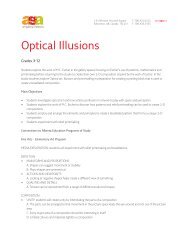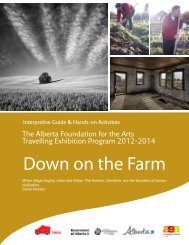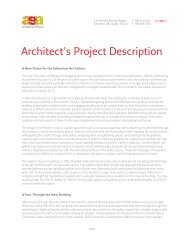Urban Animals - Art Gallery of Alberta
Urban Animals - Art Gallery of Alberta
Urban Animals - Art Gallery of Alberta
Create successful ePaper yourself
Turn your PDF publications into a flip-book with our unique Google optimized e-Paper software.
The <strong>Alberta</strong> Foundation for the <strong>Art</strong>s Travelling Exhibition Program<br />
Animal Studies: Grizzly Bear<br />
The grizzly bear is a subspecies <strong>of</strong> brown<br />
bear that generally lives in the uplands <strong>of</strong><br />
western North America. It is thought to descend<br />
from Ussuri brown bears which crossed to Alaska<br />
from Eastern Russia 100,000 years ago, though<br />
they did not move south until 13,000 years ago.<br />
The word ‘grizzly’ refers to the ‘grizzled’ or grey<br />
hairs in the animals’ fur.<br />
Jason Carter<br />
Mother Bear and her cub in the backcountry <strong>of</strong><br />
<strong>Alberta</strong>, 2012<br />
Acrylic on canvas<br />
Collection <strong>of</strong> the artist<br />
Grizzly bears are North America’s second<br />
largest land carnivore, after the Polar bear.<br />
Size and weight varies greatly according to<br />
geographic location. The largest populations<br />
are found in coastal areas where weights are as<br />
much as 550 kg (1,200 lb). The females are on<br />
average 38% smaller than the males.<br />
On average grizzly bears stand about 1<br />
metre (3.3 ft.) at the shoulder when on all fours<br />
and 2 metres (6.6 ft.) on their hind legs.<br />
The grizzly bear’s colouring ranges widely<br />
depending on geographic areas, from white to<br />
almost black to all shades in between. Their fur is<br />
very thick to keep them warm in brutal, windy, and<br />
snowy winters. The grizzly also has a large hump<br />
over the shoulders which is a muscle mass used to<br />
power the forelimbs while digging.<br />
The muscles in the back legs are very powerful, providing enough strength for the bear to stand<br />
up and even walk short distances on its hind legs, giving it a better view <strong>of</strong> its surroundings.<br />
Despite their large size, grizzlies can run at speeds <strong>of</strong> up to 55 kilometres per hour.<br />
Grizzly bears have one <strong>of</strong> the lowest reproductive rates <strong>of</strong> all terrestrial mammals in North<br />
America. This is due to numerous ecological factors. First, grizzly bears do not reach sexual<br />
maturity until they are at least five years old. Once mated with a male in the summer, the female<br />
delays embryo implantation until hibernations, during which abortion can occur if the female<br />
does not receive the proper nutrients and caloric intake. On average, females produce two cubs<br />
in a litter and the mother cares for the cubs for up to two years. During this time the female will<br />
not mate and, even once the young leave, females may not produce another litter for three or<br />
more years depending on environmental conditions. Exacerbating all <strong>of</strong> this is the fact that male<br />
grizzly bears have large territories ranging up to 4,000 square kilomteres. This makes finding a<br />
female scent difficult in such low population densities.<br />
AFA Travelling Exhibition Program, Edmonton, AB. Ph: 780.428.3830 Fax: 780.421.0479<br />
youraga.ca

















